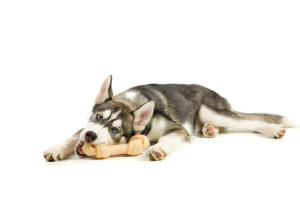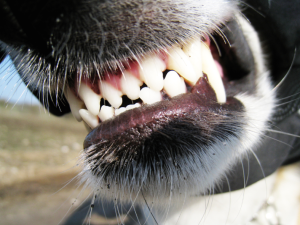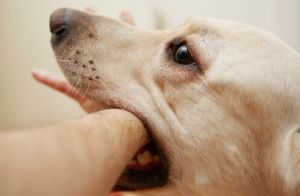Dog b ites hurt! Even when they don’t break skin, the mere pressure of the canine jaws is enough to inflict serious pain. Many of us have experienced at least one traumatic chomp. The speed and brutality of the act often catches us by surprise and will most definitely stop us dead in our tracks. We’re lucky if the dog inflicts us with a single unceremonious bite as he could have reacted to our perceived rudeness with a series of snapping munches. In the U.S. alone, about 4.5 million people were bit last year with almost half of them being children (2 million). This week is National Dog Bite Prevention week, a time to bring awareness to the problem and educate people about preventing dog bites. No matter the breed, the size, the age or the sex, all dogs have the potential to bite. When they feel threatened, they may use the weapons nature equipped them with: a mouthful of powerful teeth. Why are so many people being bit? What happens between man and his best friend that lead to such painful outcomes? To better understand where things might go wrong, lets take a look at some of the most effective ways to push Fido over the edge.
ites hurt! Even when they don’t break skin, the mere pressure of the canine jaws is enough to inflict serious pain. Many of us have experienced at least one traumatic chomp. The speed and brutality of the act often catches us by surprise and will most definitely stop us dead in our tracks. We’re lucky if the dog inflicts us with a single unceremonious bite as he could have reacted to our perceived rudeness with a series of snapping munches. In the U.S. alone, about 4.5 million people were bit last year with almost half of them being children (2 million). This week is National Dog Bite Prevention week, a time to bring awareness to the problem and educate people about preventing dog bites. No matter the breed, the size, the age or the sex, all dogs have the potential to bite. When they feel threatened, they may use the weapons nature equipped them with: a mouthful of powerful teeth. Why are so many people being bit? What happens between man and his best friend that lead to such painful outcomes? To better understand where things might go wrong, lets take a look at some of the most effective ways to push Fido over the edge.
1. Bother a dog when eating, chewing a bone or toy
 Most dogs have no problems with having humans around while they’re eating and will even tolerate being touched or having their food played with. But living in an environment where the humans control all the goodies means that dogs have little to no decision power over their access to food. For most dogs, food is a very high resource. Depending on their genetics and their history, some dogs may have more anxiety than others about losing this resource. So if we don’t know the dog, we may pay a price if we expect him/her to be OK when we approach. Even dogs that are generally tolerant of people when they eat their regular meal may act differently when given something special. I have seen dogs suddenly get very protective over certain types of toys.
Most dogs have no problems with having humans around while they’re eating and will even tolerate being touched or having their food played with. But living in an environment where the humans control all the goodies means that dogs have little to no decision power over their access to food. For most dogs, food is a very high resource. Depending on their genetics and their history, some dogs may have more anxiety than others about losing this resource. So if we don’t know the dog, we may pay a price if we expect him/her to be OK when we approach. Even dogs that are generally tolerant of people when they eat their regular meal may act differently when given something special. I have seen dogs suddenly get very protective over certain types of toys.
Prevention: Better breeding practices with careful selection of parents without this trait, and also systematic prevention, go a long way in preventing problems with resources. All dogs need to learn that having others (adults, children or even other pets) in their presence while they eat isn’t a threat. Hand feeding the dog or going over to her while eating to toss special treat in the bowl then leave are some of the ways to help the dog look forward to our presence, not tighten up. We can also play exchange games where we give the dog something even better in exchange for what he/she has, then give the valued object back. Any punishment in this situation will only make matters worse. After all, we would only be confirming the dog’s apprehension.
2. Bother a sleeping dog
Just like people, dogs can get startled. When a child climbs on a dog while taking a nap, even the sweetest of dogs can bite. This behavior is a reflex for the dog, not an intentionally aggressive act and should not be punished. A dog that tends to bite when startled could also bite when surprised by a kiss or other physical touch, even when fully awake.
Prevention: When we don’t know the dog, it’s always best to never bother a sleeping dog. If we know the dog and are aware that she may be a little jumpy, it’s best to make a sound to first get the dog’s attention, like calling her name, clapping or stomping our feet, then touch her when she’s expecting the physical contact.
3. Stepping in a yard with a dog left unattended
5, 581 US Postal Service workers were bit last year (Postal Service Release, 2014). Why? Because many times a day, they’re job requires them to step onto people’s properties to deliver the mail. When dogs feel threatened by a stranger approaching their home, they will typically bark incessantly until the stranger is gone. But if the dog is left outside or can push through an open door, some will lunge at the intruder (mailman or anyone else) and may cause injury. In such situations, dogs may or may not bark. Depending on the breed or the history of the dog, there may be little to no warning signs before the aggressive display.
Prevention: The best way to prevent this type of bite is of course to avoid stepping into a property with a dog without the owner being there to mange the pooch. When in a situation where avoiding the problem is no longer an option, and a dog is coming lunging and snarling, the best way to protect yourself is to stay calm, do not move and keep your arms tucked in, out of the way of the dog. Yelling, running, waving your arms would only trigger more aggression. When owning a dog, regardless of prior history, we need to make sure our dogs cannot get lose and run unsupervised under any circumstances. We don’t want to see someone traumatized by the first time our dog bites, just because we didn’t see it coming.
4. Hitting a dog
 Hitting a dog or physically threatening or hurting a dog, no matter what he/she did, teaches the dog that we can be a source of pain, discomfort and fear. With repetition, the dog will become increasingly anxious in our presence. Just like when we’re on edge, stressed out dogs are quicker at reacting and develop more behavior issues in general. We then step into a vicious cycle of behavior issues leading to punishment, leading to behavior issues, etc… In such an environment, many dogs start displaying behaviors meant to stop the perceived threat and will bark, growl and eventually bite the hand that feeds them.
Hitting a dog or physically threatening or hurting a dog, no matter what he/she did, teaches the dog that we can be a source of pain, discomfort and fear. With repetition, the dog will become increasingly anxious in our presence. Just like when we’re on edge, stressed out dogs are quicker at reacting and develop more behavior issues in general. We then step into a vicious cycle of behavior issues leading to punishment, leading to behavior issues, etc… In such an environment, many dogs start displaying behaviors meant to stop the perceived threat and will bark, growl and eventually bite the hand that feeds them.
Prevention: When we can develop a relationship with our pet based on trust and understanding, we help our dog feel safe and confident. Everybody benefits. There is never a need for being harsh with our dogs. If we can’t find another way to get what we want, it’s time to seek advice from professionals.
5. Separating fighting dogs
When a fight breaks out between dogs, it can be very stressful for the people around. Although most fights end quickly with hardly a scratch, we generally feel compelled to intervene and separate the dogs. Anytime we stick our hands in a fight to pull the dogs apart, we risk a bite. Whether we get bit because our hand accidently fell in the wrong mouth, or because the dog redirected the aggression on us, because of our own constitution, we are more at risk than the dogs themselves. Again, this is a reflex. In rare instances, the fighting dogs may turn on the humans and gang up on the person trying to separate them.
Prevention: Proper socialization, but also learning how to recognize when playing is escalating and getting too rough, can help prevent a fight to happen in the first place. We can be the referee and give them short breaks to allow them to cool down. But even in the best of conditions, sometimes fights happen. Staying calm is critical to avoid escalation. Because I always have multiple dogs, and many times they are new to each other, I make sure I’m prepared in case of a scuffle. The water bowl always stays full. Throwing water, making a loud sound or sliding something in between the dogs (like a piece of plywood or a chair) is a safer and more effective alternative than going in with our hands.
6. Hugging or restraining a dog
Dogs don’t like being hugged. When we have a relationship with the dog and they feel safe with us, most dogs will put up with our display of affection. When interacting with a strange dog however, it’s a bad idea to hug or restrain the dog in any way (unless we absolutely have to, e.g.: veterinary procedures). If the stress level of the dog raises beyond that of simple discomfort he/she may think of no other way to get out of the embrace, than with a bite.
Prevention: No living being likes to be restrained. We can help our dogs develop more tolerance with systematic desensitization. For more information about how to do this, visit “The importance of preparing animals for the vet”.
7. Petting a leashed dog without checking with the owner
 As a service dog trainer, I’m always out in public with one dog or the other. There isn’t a day that goes by without someone wanting to pet the dogs. Fortunately, most people have learned to ask before they interact with the dog, which gives me the opportunity to educate both the person and the dog in training. There are those however who will do ‘drive by petting’ or worse, send their kids running to the dogs and pet them. No matter the dog, service dog or pet dog, when on a leash, the dog is restrained. In other words, if scared for any reason, with the ‘flight’ response out of question the dog is capable of a ‘fight’ reaction to a perceived threat. What’s the dog’s history? How does the dog react when startled? What’s the stress level of the dog in this particular situation? How much experience does the handler have?
As a service dog trainer, I’m always out in public with one dog or the other. There isn’t a day that goes by without someone wanting to pet the dogs. Fortunately, most people have learned to ask before they interact with the dog, which gives me the opportunity to educate both the person and the dog in training. There are those however who will do ‘drive by petting’ or worse, send their kids running to the dogs and pet them. No matter the dog, service dog or pet dog, when on a leash, the dog is restrained. In other words, if scared for any reason, with the ‘flight’ response out of question the dog is capable of a ‘fight’ reaction to a perceived threat. What’s the dog’s history? How does the dog react when startled? What’s the stress level of the dog in this particular situation? How much experience does the handler have?
Prevention: As a rule of thumb, we should NEVER approach a strange dog. For our sake as well as for the dog, we need to make sure to check with the person on the end of the leash. Most dogs feel safer when they initiate the interaction, not the other way around.
8. Roughhousing with a dog
So many of us enjoy a little roughhousing with dogs now and then, especially guys. Nothing wrong with that, except that without certain boundaries in place, play can escalate to the point of injury. Dogs may nip their owner during play and could do the same when mistakenly see an opportunity for roughhousing with strangers.
Prevention: Don’t let roughhousing escalate and get out of hand. Just like when dogs play with one another, take many mini breaks to let the situation cool off a bit. Have rules in play, such as no mouthing, nipping, jumping, etc. You can read more about the subject in the following blog : “Roughhousing with dogs, rules and consequences”.
9. Running and screaming at the sight of a dog
What is more exciting to a dog than a person running away while screaming while moving erratically? If we’re afraid of dogs and this is how we react when we see them, our fear will become a self-fulfilling prophecy. Most dogs naturally chase moving targets, and if we sound like a shrieking animal, we only make things worse.
Prevention: When walking by a dog, staying calm and controlled is always the safest option.
10. Ignoring the dog’s warning signals!
If we were to move to a foreign country, wouldn’t we make sure to learn the language? When living with dogs, we need to make the effort to learn their language. Many of us don’t understand warning signals and get confused and stunned when their beloved pet bites ‘out of the blue’. When you know what to look for, warning signs are there. The problem is when the human repeatedly ignores them and pushes the dog beyond his comfort level.
Prevention: responsible guardianship comes with a basic understanding of dog body language. When is the dog stressed, scared or defensive? Dogs are very clear in the way they express their emotions and recognizing them allows us to make changes in the environment to prevent accidents.
Dog bites often seem to happen as an accident, but most are preventable. We all live around dogs whether we own one or not and can all contribute to limiting the number of traumas due to man’s best friend. In a society where bites are not tolerated and can lead to a death penalty to the dog, it’s even more important to do what’s in our power to make a difference. So that bite prevention week isn’t just a date on the calendar.
Jennifer Cattet Ph.D.




All good points, and only reinforces the need to socialize your dogs early and often, and for every possible experience, to ensure they will be fully participating members of the family. Plus they will be less likely to end up in a shelter, or worse. Thanks for sharing such important information.
Very good points. as a child I was bitten by my friends German Shepherd whom I had played with almost daily but one day I startled him and he ran after me and severely bit my leg after he got me down on the ground. Fifty years later I still have the marks that he left on my leg. I required hospitalization for his bite.
those are good reasons to avoid mean dogs. good tips.